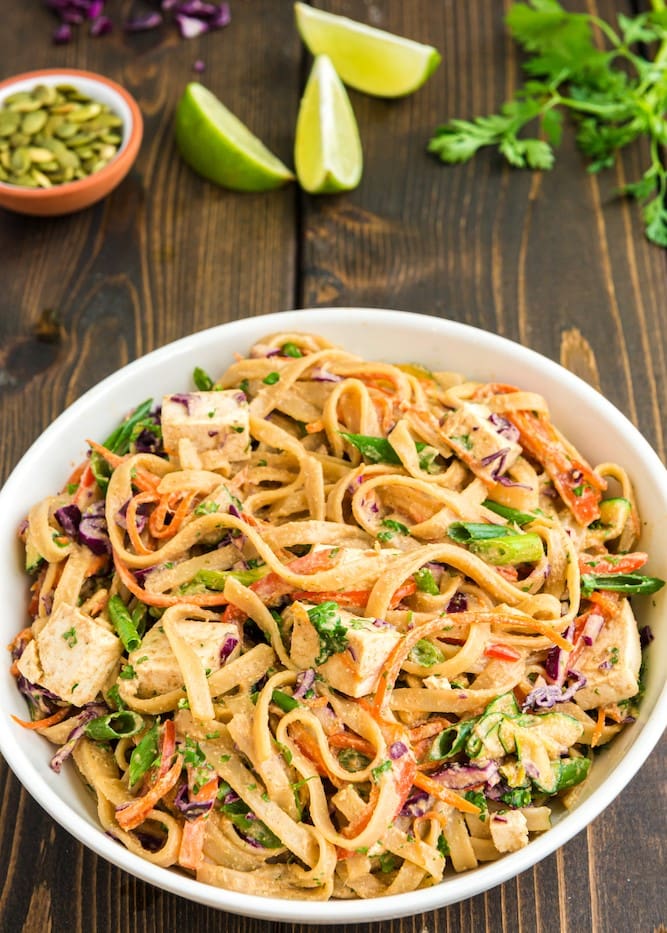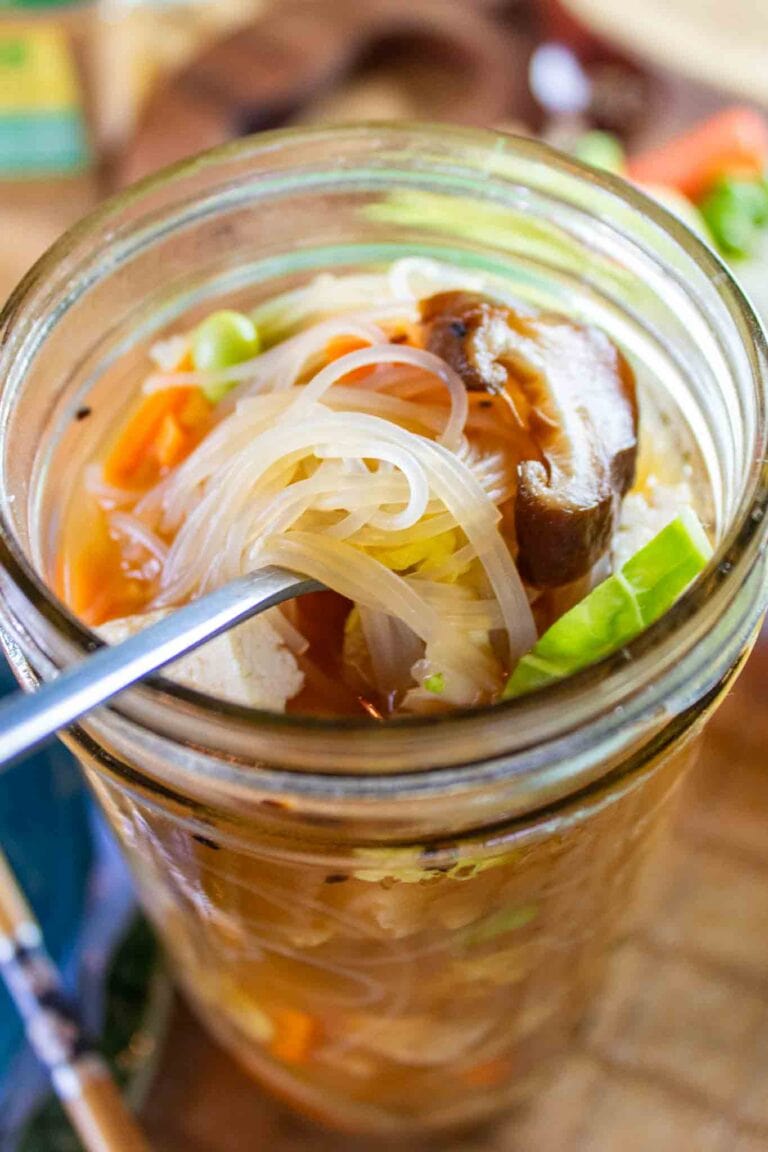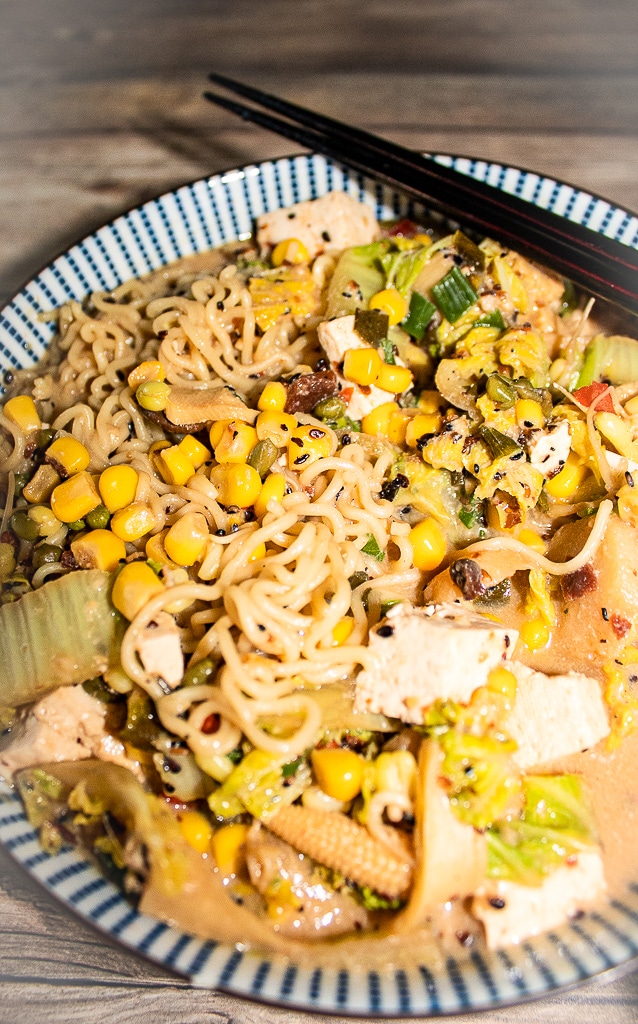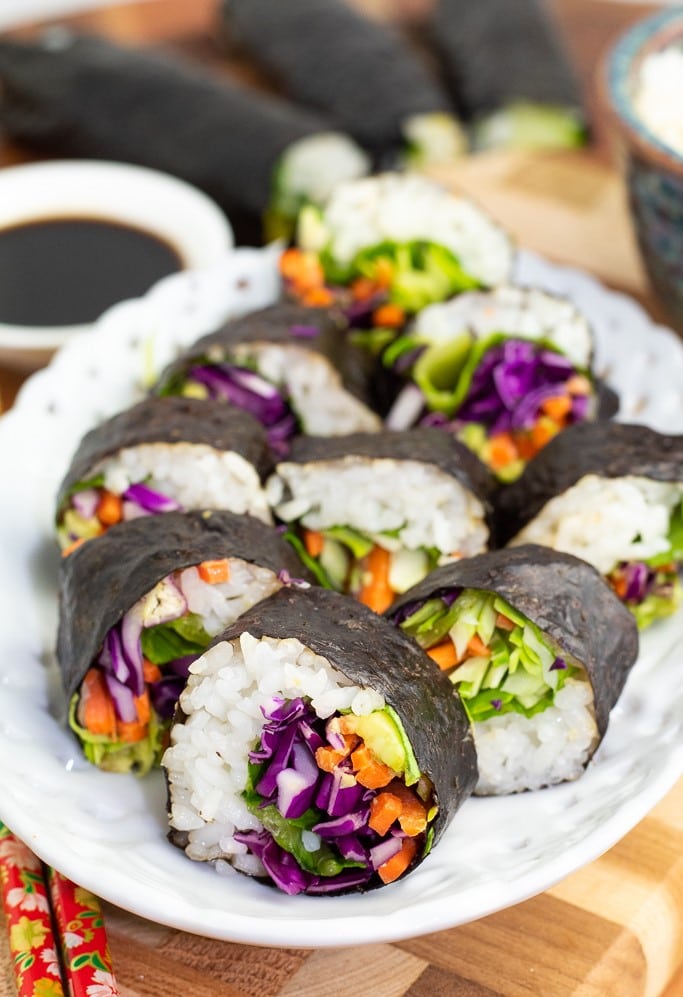Japanese Somen Cold Noodle Soup Recipe
This quick and easy somen cold noodle soup recipe is a perfect light meal for cooling down on hot summer days. It is made with a delicious dashi broth and filled with hearty shiitake mushrooms and onions. You will love the ease and comfort it offers, and it’s prepared in a mere 20 minutes!

The summer heat can be brutal, and when it’s sweltering outside, nothing sounds good for lunch. Let me share an ancient Japanese secret–slurping cold Japanese somen noodles is the perfect solution! Somen noodles are a traditional Japanese summer food for that very reason, they are served cold and are delicious in the heat.
Nothing is more refreshing than cold somen noodles and the rich umami flavor of tsuya dashi broth on a hot day! They are the perfect summer food and easily served for one or with a group of family and friends.
If you like to keep it super simple, with only about 15 minutes, you can even meal-prep these easy Asian Mason Jar Soups to have on hand for grab-and-go meals.
Reasons you will love this Asian soup
- Light and Refreshing: This Japanese somen cold noodle soup offers a cool and refreshing meal, perfect for hot days when you crave something light yet satisfying.
- Vegan and Plant-Based: Completely vegan, this somen noodle soup provides all the traditional flavors of Japanese cuisine without any animal products, making it a delicious choice for plant-based eaters.
- Healthy and Low-Calorie: This cold noodle soup is not only tasty but also low in calories and packed with nutrients, making it a healthy option that doesn’t compromise on flavor.
What are somen noodles?

Somen noodles are very thin, white, Japanese noodles made of wheat flour, water, and salt. They are made by stretching the dough to make very thin noodles and then they are air-dried. Once the noodles are cooked, we rinse them thoroughly in a sieve with cold water. Somen noodles are served with ice to keep them cool.
Somen soup broth or Mentsuyu (for dipping)
Somen Noodles are normally served with a cold dipping sauce called tsuya or mentsuya. In Japanese, men means noodles and tsuya means sauce or broth.
Our plant-based mentsuya (noodle soup base) is made from my kombu dashi recipe, so it is enhanced with a rich umami flavor. Mentsuya is commonly used for dishes like tempura, udon, soba, and somen noodles, but it can also be used to season a variety of other dishes including vegetables and fried rice.
If it becomes the favorite at your house that it is in ours, it may help to double or triple the recipe when you make it for days when you come home ravenous and want to something satisfying that can be prepared in basically the time it takes to boil water.
A word of caution about store-bought mentsuya
Making mentsuya from scratch is super-fast, easy, and free from preservatives and MSG. This is good because I have not been able to find a prepared plant-based mentsuya sauce. I occasionally think I have found one, some even advertise themselves that way and they are made from kombu dashi, but when I read the ingredient list it includes bonita flakes or katsuobushi, which is fish. So be mindful of this and check the labels carefully when shopping for store-bought varieties.
Methods for serving somen noodles
Somen can be served in a variety of ways and can even be dressed up and made for more formal occasions. The method I am recommending is one that I adapted for convenience (and safety as a result of Covid) that has actually turned out to be our ‘new norm.’ It requires a few more bowls, but we can spread out more and there’s less dripping!
This method will require each person to have two bowls. The noodle bowl should be about the size of a cereal or soup bowl, and the tsuya bowl can be the same size or a little smaller.
The tsuya soup base bowl, usually the smaller of the two bowls, is the one that you will eat from. Go ahead and ladle your tsuya broth into your bowl while you’re cooking the noodles and it will cool more quickly. You can use a spoon to eat your broth, but it’s perfectly acceptable, and even expected, for you to turn up your bowl and drink from it. Trust me, you’re gonna want to try it–it’s life-changing.
Now, noodle bowl! Fill your somen noodle bowl about half-full with cold water and several ice cubes. Once the noodles are rinsed, add a serving of somen to each noodle bowl. Somen noodles are served in ice water because as you eat you move the ice-chilled noodles to the soup broth and then immediately to your mouth. Summer cool deliciousness!
Eating with chopsticks
Quick side note on eating and cooking with chopsticks. You should definitely try it! I know, I know…it seems counter-intuitive. I think I vaguely remember even using the word primitive when I tried to make my case to my Japanese father-in-law who was insisting I learn to eat ‘properly’ when I first moved to Japan.
Fast forward 30 years, and he was so right. One of the top 3 (out of 50 million) best things he ever made me do. Once you learn, you’ll never want to cook or eat with anything else. PLUS! Now you have the benefit of YouTube, so you don’t even have to sit in front of him trying to pick up pieces of a crumbled cookie for hours!
I have no idea how I would have survived motherhood had I not learned–there has never been a rogue mushroom in a soup bowl or Lego in the toilet bowl that I couldn’t retrieve without skilled precision! Win-Win!
To eat, use your chopsticks or tongs to move some of the noodles from your somen noodle bowl into your tsuya soup base bowl. Give them a second and let some of the water drain before you transfer them to your tsuya bowl to lessen dripping and the dilution of your soup base.
I find disposable wooden chopsticks are easiest to use with slippery noodles so if you’re up for trying them and you have that set left over from take-out saved in a drawer, this is the moment you’ve been waiting for! No worries though, if you’re skilled at eating ramen with a fork, this will work the same way!
Once you have your noodles in your soup bowl, add your garnishes and start slurping! Refill your tsuya bowl from your noodle bowl each time you run out. Move them a little at a time as you eat so that with each new bite you continue to get that great sensation of ice-chilled noodles.
Traditional eating method
Now, just so you know how somen is traditionally eaten because you never know when you’re going to want to mix it up a bit!
- Family Style- Serve the chilled noodles in a large bowl of ice water with plenty of ice cubes.
Up until a couple of years ago, we only served somen family style, like you would in Japan, when eating it. Everyone has their own tsuya bowl and there’s a large ‘central’ somen bowl in the middle of the table that everyone refills from. If you are concerned about eating from a community bowl, try using tongs or flipping your chopsticks around when you pick up noodles. Use the pointy end for eating and the rounded/squared-off ends for scooping! This way is, of course, the most casual and it’s a great way to spend time together at a table while you’re eating. Refilling your bowl necessitates it!
- More Formal Style- If you’re serving somen to guests and want to make it a little more special, serve the cold noodles on small individual plates with just a little bit of water and a few ice cubes drizzled over the top. You can add the garnishes listed in our recipe in small bowls to the middle of the table and let everyone dress up their own tsuya bowl.
- Getting Fancy- If you want to do something exceptional and have an artistic flair, traditional Japanese restaurants will sometimes tie up the noodles with an edible ‘thread’ and arrange them to look like roses on the plate. You can search for images and probably instructions on the internet. I’m no help here, but they’re beautiful!
Optional toppings
These can be placed in individual small bowls to be sprinkled on top of the menstuya soup base as desired.
- 1 knob grated ginger (1/2 inch). I highly recommend using ginger, and no shame, the refrigerated tube variety will work fine too.
- Green onion/scallions, chopped into small thin circles
- Toasted white sesame seeds
- Shredded nori seaweed
How to make somen noodle soup
The recipe card at the bottom of the page has the full list of ingredients with measurements and instructions.
STEP #1: Make your tsuya soup base first so that it can be cooling while you boil the noodles. Ideally, you can do this ahead of time and keep it on hand.
STEP #2: Combine the soup-base ingredients in a saucepan and bring it to a boil over high heat. Reduce heat and let it simmer for 7- 9 minutes or just until the onions are translucent.
STEP #3: Remove from heat and let cool while you prepare your noodles. You can transfer it to the refrigerator to chill if you want to speed things up. If you’re in a rush, you may be tempted to add ice cubes to chill your dipping sauce, and it works, just bear in mind that you’re diluting your dipping sauce a bit.
Tips on dilution:
We like our tsuya with a bold flavor, but you can adjust the intensity of the broth to suit your preferences. With less dashi, the flavor is more robust as the mirin and shoyu ratios are increased.
If you prefer a weaker flavor, add more dashi to dilute it. Bear in mind when deciding, that your broth will also be further diluted as a part of the eating process. When you eat somen, you move the noodles from a bowl of ice water into your soup base bowl. As a result of the wet noodles being transferred to your bowl, it dilutes pretty quickly on its own. Just experiment and see which you like best!
Cooking method for somen noodles
STEP #4: Use 4 wrapped bundles of somen noodles. If they are not pre-wrapped, a 1” (about the circumference of a quarter) diameter is about the size of a bundle.
Bring a large saucepan of water to a boil. Remove all the wrappings from the somen bundles, if they’re wrapped, while you’re waiting.
STEP #5: Add the noodles to the boiling water all at once. Fan them out while you’re dropping them into the pot to discourage them from sticking together.
Cook the noodles for 1½ to 2 minutes or according to the package instructions. Continue to stir them occasionally to prevent them from clumping together.
STEP #6: Once cooked, immediately drain the noodles by pouring them into a colander with small holes and then gently rinse the noodles well under cold running water to remove the excess starch. Once cool enough to touch, I like the use my hand to knead them a little to aid with the rinsing.
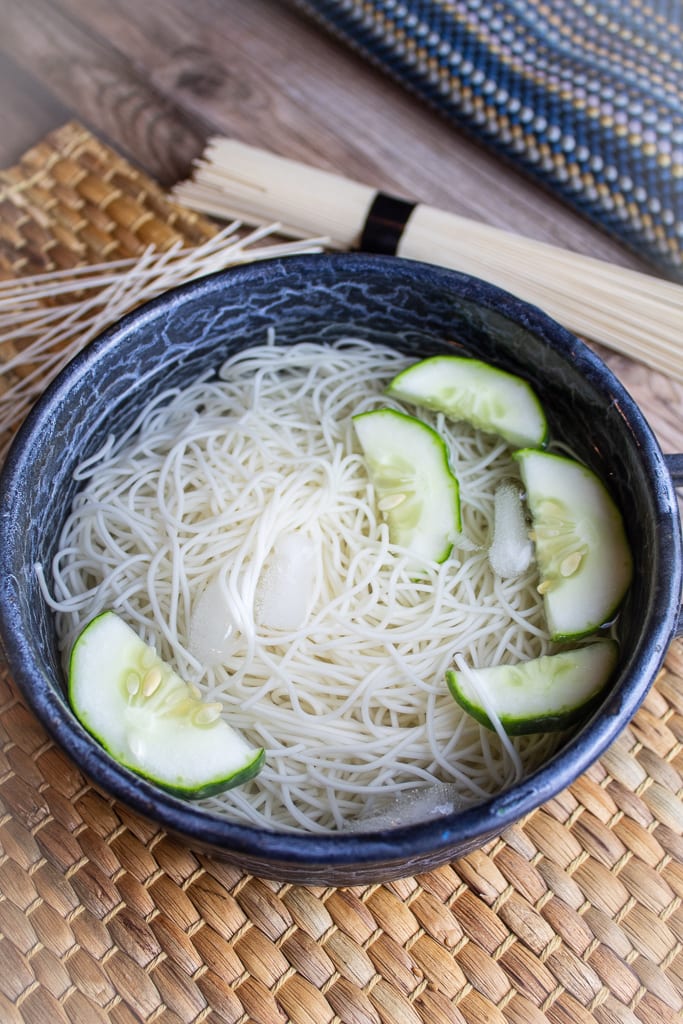
STEP #7: When you finish rinsing, transfer the somen to your serving bowls of iced water with several ice cubes. See my detailed instructions above on how to serve this dish the traditional Japanese way as well as other options.
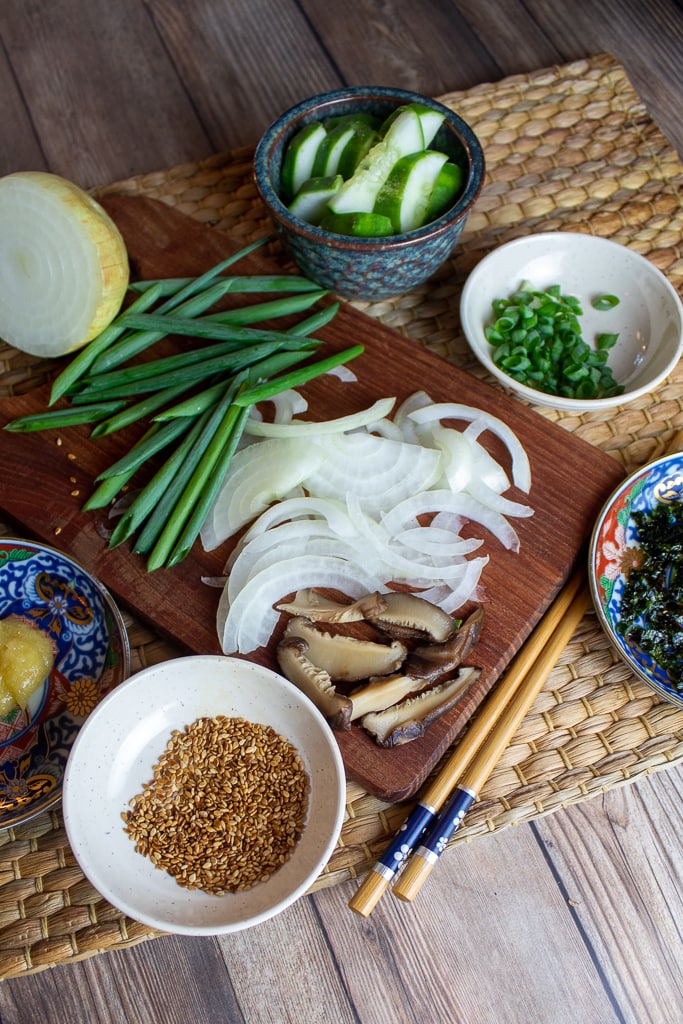
STEP #8: A few fresh basil leaves or cucumbers sliced into thin rounds and placed in the somen noodles give the bowl a splash of color.
Storage & pro tips
You can keep the leftover tsuya in an airtight container and store it in the refrigerator for up to 3 days. It can also be frozen so you will have it on hand for future somen meals and to use in other dishes.
- Plan A: Ideally, you want to boil the noodles right before serving if you’re able.
- Plan B: It may affect the noodle texture a little, but somen noodles can be refrigerated without water for 2 to 3 days. They tend to stick together so you’ll probably need to run them under cold water to loosen them back up before serving.
- Plan C: I’m breaking protocol here and my mother-in-law would cringe over this one, but I’m just going to go ahead and do it anyway. Full disclosure, I occasionally refrigerate them in ice water overnight in a mason jar or thermos. (If you try this, leave your basil leaves or cucumber in and it will infuse them with a light flavor that’s wonderful!) This method makes them easy to store overnight and pack for a quick lunch. The noodles will probably expand a little and become less ‘springy’, but it’s a convenient way to take something that you don’t have to heat up and the noodle texture change isn’t significant to me.

For those of you new to the whole food plant-based lifestyle, we’ve created a FREE 7-Day Plant-Based Menu Planner to help you get started!
If you try this recipe, please let us know how you like it by rating it and leaving a comment. We love to hear from you!
Want to Save This Recipe?
Enter your email & I’ll send it to your inbox. Plus, get great new recipes from me every week!
By submitting this form, you consent to receive emails from EatPlant-Based

Japanese Somen Cold Noodle Soup
Ingredients
- 4 cups Dashi Japanese soup stock (link included)
- 1/3 cup low-sodium soy sauce
- 1/4 cup mirin
- 1 tablespoon sugar or other sweetener
- 1 cup onions thinly sliced into strips
- 4 green onions diced, optional
- 4 Shitake mushrooms sliced into strips (optional)
- 4 bundles somen noodles 1" diameter= a bundle
Instructions
- Make your tsuya soup base first so that it can be cooling while you boil the noodles. Ideally, you can do this ahead of time and keep it on hand.
- Combine the soup-base ingredients in a saucepan and bring it to a boil over high heat. Reduce heat and let it simmer for 7- 9 minutes or just until the onions are translucent.
- Remove from heat and let cool while you prepare your noodles. You can transfer it to the refrigerator to chill if you want to speed things up. If you’re in a rush, you may be tempted to add ice cubes to chill your dipping sauce, and it works, just bear in mind that you’re diluting your dipping sauce a bit.
- Use 4 wrapped bundles of somen noodles. If they are not pre-wrapped, a 1” (about the circumference of a quarter) diameter is about the size of a bundle.
- Bring a large saucepan of water to a boil. Remove all the wrappings from the somen bundles, if they’re wrapped, while you’re waiting.
- Add the noodles to the boiling water all at once. Fan them out while you’re dropping them into the pot to discourage them from sticking together.
- Cook the noodles for 1½ to 2 minutes or according to the package instructions. Continue to stir them occasionally to prevent them from clumping together.
- Once cooked, immediately drain the noodles by pouring them into a colander with small holes and then gently rinse the noodles well under cold running water to remove the excess starch. Once cool enough to touch, I like the use my hand to knead them a little to aid with the rinsing.
- When you finish rinsing, transfer the somen to your serving bowls of iced water with several ice cubes. See my detailed instructions above on how to serve this dish the traditional Japanese way as well as other options.
Video
Notes
- 1 knob grated ginger (1/2 inch). I highly recommend using ginger, and no shame, the refrigerated tube variety will work fine too.
- Green onion/scallions, chopped into small thin circles
- Toasted white sesame seeds
- Shredded nori seaweed
- Plan A: Ideally, you want to boil the noodles right before serving if you’re able.
- Plan B: It may affect the noodle texture a little, but somen noodles can be refrigerated without water for 2 to 3 days. They tend to stick together so you’ll probably need to run them under cold water to loosen them back up before serving.
- Plan C: I’m breaking protocol here and my mother-in-law would cringe over this one, but I’m just going to go ahead and do it anyway. Full disclosure, I occasionally refrigerate them in ice water overnight in a mason jar or thermos. (If you try this, leave your basil leaves or cucumber in and it will infuse them with a light flavor that’s wonderful!) This method makes them easy to store overnight and pack for a quick lunch. The noodles will probably expand a little and become less ‘springy’, but it’s a convenient way to take something that you don’t have to heat up and the noodle texture change isn’t significant to me.
Nutrition
Disclaimer
To obtain the most accurate representation of the nutritional information in a given recipe, you should calculate the nutritional information with the actual ingredients used in your recipe, using your preferred nutrition calculator. You are solely responsible for ensuring that any nutritional information provided is accurate, complete, and useful.
About the Chef
Drenda-Michell Brennan lived in Japan in the 1980s and 90s where she enjoyed spending much of her time visiting the kitchens of family and friends, watching and learning to prepare traditional Japanese cuisine. She is the mother of three Japanese-American grown children and grandmother (HuneyGram) to nine grandchildren. Read More…

